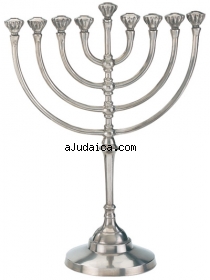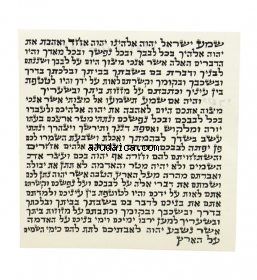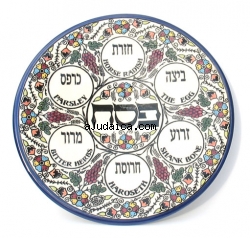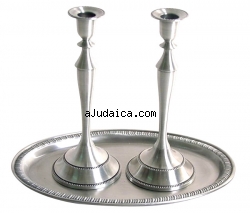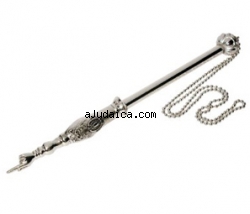Jewish Gifts
Why are Jewish gifts so popular these days?
Although Jewish communities have been scattered around the world in the last two millenniums, the authentic core of the Jewish identity has been preserved. Every Jew at some point in their lives will affix a mezuzah to a doorpost, light a menorah candle on Shabbat or Hanukkah, or feel connected to the Star of David symbol. These experiences and elements of the Jewish tradition have been preserved for thousands of years and today they are more relevant than ever. Despite the processes of secularization and globalization that have impacted the modern society across the globe in major ways, there has been a strong need for defining and expressing one's cultural identity.
How have the Jewish tradition and collective identity survived these turbulent times, overcoming many obstacles? Since the Jewish people was expelled from the land of Israel, two thousands of years ago, traditional symbols and ritual objects have played a significant role in preserving the bond between the distant Jewish communities and the holy land. These signs and rituals have distinguished Jewish minorities in all parts of the world, often resulting in their prosecution.
In the last century, especially since World War Two and the establishment of Israel, the Jewish identity has become a source of pride. Judaica has turned into a popular way to express religious faith and national pride. Within the Jewish community, it has become a popular custom to give and receive gifts that carry Jewish symbolism, commonly referred to as Jewish gifts . Today, it is common to exchange ritual objects and symbolic Jewish jewelry that bring religion and art together, and so celebrate the richness of the Jewish culture. The growing demand of wide markets has led to a drastic development in the field of Judaica art and jewelry. In recent years Judaica artists have created a vast selection of Jewish gifts , from small rings decorated with Jewish motifs to impressive and elaborate Hanukkah menorahs and Seder plates.
What makes modern Jewish gifts so special?
First, Jewish gifts today successfully marry ancient heritage with fresh, modern spirit. Contemporary Judaica artists offer unusual and bold interpretations to traditional religious symbols. Thanks to them, today we can find mezuzahs in humorous colors or Seder plates in metallic designs. These Judaica artworks cross the boundaries of what was used to be thought of as purely religious objects that need to be simple and grave. Now we can find flower-shaped Shabbat candlesticks or a mezuzah designed as a spaceship! Judaica artists undeniably contribute their share to spark and incite our imagination while re-examining our traditional definitions of what we think of as common Jewish gifts. Modern Judaica artwork and jewelry design make a strong case for the relevance of Judaism today more than ever before.
Nowadays, you can also find new ideas for Jewish gifts that have not been considered before. We can recognize, for example, the influence of the feminist movement in many religious practices. One such new Judaica object is a Tallit especially designed for women. Another object is Miriam's Cup placed on the Seder table beside the traditional Cup of Elijah. The ritual of Miriam's Cup is intended to draw our attention to the significance of women in the story of Exodus. Filling this Cup in Water at Passover dinner signifies Miriam's Well which turned to be a miraculous source of water for the Israelites in the desert. These new objects successfully reflect the changes in the modern Jewish society over time.
But Jewish gifts include much more than ritual objects. The Hamsa Hand, for example, is a symbol that has been widely adopted by Judaism and used by Jews to this day. The Hamsa Hand is believed to draw positive energies and good luck and ward off any evil. It is not surprising then to find the Hamsa Hand on many jewelry accessories, key chains and a wide variety of other decorative objects. Notwithstanding of its original use, it's fair to say that many people are drawn to the Hamsa symbol because they simply like the way it looks.
Jewish gifts not only merge the old with the nouveau but also bring together the Western and Eastern worlds. Throughout history, Diaspora Jews have lived mainly in Europe, Arab countries, and, with the immigration waves of the twentieth century, also in North America. The hundreds of thousands of Jewish immigrants from across the world who now live in Israel well exemplifies this unique mix of cultural elements. In Israel, Judaica art often gives special attention to diverse cultural influences. Israeli-made Jewish gifts are inspired by Jewish and Israeli symbolism that has evolved into what it is today. You can find mezuzah cases and other objects that are inspired by The Western Wall, for example. The Wall is a prominent motif that represents the grief of the Jewish people for the loss of the second temple destroyed over two thousands years ago. You can also find delicate Jewelry designs with Hebrew inscriptions of famous Jewish prayers such as Shema Yisrael (Hear O Israel!), or verses from the book of Psalms and the Torah

